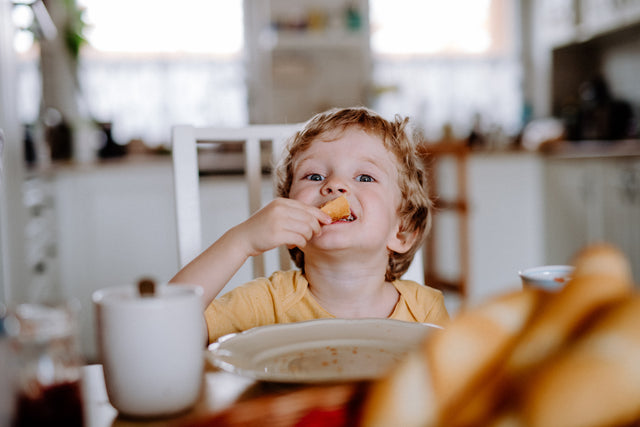A Portion Size Guide for Toddlers 1 to 3 Years

Toddlers are famous for their fickle appetites—so when it comes time to plop food on their plate, you might feel like you’re dealing with a little Goldilocks. How much is too much or too little to serve a toddler?
Because large amounts of food can be daunting for new and seasoned eaters alike, a good rule of thumb is to offer your tiny muncher a small amount at a time. That way, they aren’t overwhelmed by the portion, and if they want more, they won’t hesitate to let you know!
Remember, it’s your job to serve the food, but it’s your tot’s job to figure out how much they want to eat. Ultimately, you want to train your toddler to trust their own bellies (so that means not pressuring them to clean their plates!).
Still, you’ve got to start somewhere—so here’s a guide to toddler portion sizes!
Portion Sizes for Toddlers Ages 1 to 3 Years
According to the American Academy of Pediatrics, a toddler serving is one-quarter of an adult’s serving—but what does that mean? Here’s a cheat sheet of how much of each food group to serve to your toddler.
Grains Portion Size for Toddlers
Toddlers need six servings of grains a day. One toddler-sized serving of grains equals:
- 1/4 cup Cheerios
- 1/4 cup pasta, rice, or quinoa, cooked
- 1 to 2 crackers
- 1/2 slice of bread
Dairy Portion Size for Toddlers
Toddlers need two to three servings of dairy a day. One toddler-sized dairy serving equals:
- 1/2 cup of whole milk (for ages 1 to 2)
- 1/2 cup of 2% milk or fortified soy milk or pea milk
- 1/3 cup of yogurt
- 1/2 ounce of cheese
Vegetable Portion Size for Toddlers
Toddlers need two to three servings of veggies a day. One toddler-sized serving of veggies depends on their age—they need roughly one tablespoon per year. For example:
- Age 1: 1 tablespoon of veggies
- Age 2: 2 tablespoons of veggies
- Age 3: 3 tablespoons of veggies
Fruit Portion Size for Toddlers
Toddlers need two to three servings of veggies a day. One toddler-sized serving of fruit is a quarter cup. For example:
- 1/4 cup mandarin oranges, canned
- 1/4 cup banana slices
- 1/4 cup cut-up blueberries
- 1/4 cup unsweetened applesauce
Protein Portion Size for Toddlers
Toddlers need two servings of protein a day. One protein serving for toddlers equals roughly two tablespoons or:
- Half an egg, cooked
- 2 tablespoons ground meat, chicken, or turkey, cooked
- 2 tablespoons of fish, cooked
- 2 one-inch cubes of tofu
Legumes Portion Size for Toddlers
Toddlers need two servings of legumes a day. One toddler-sized serving of legumes equals:
- 2 tablespoons of beans or lentils, cooked
- 1 tablespoon of smooth nut butter, spread thinly
A Visual Guide to Portion Size for Toddlers
When you’re rushing to get food on your hungry tyke’s plate, you may not have a second to grab a measuring cup or spoon…so here’s help on how to visualize what a toddler serving size should look like!
1 tablespoon is about the size of:
- A poker chip
- A 9-volt battery
- The tip of your thumb
2 tablespoons is about the size of:
- a golf ball
- your whole thumb
1/2 ounce is about the size of:
- A game die
- 1/2 a tube of Chapstick
- The first joint of your pointer finger
1/4 cup (2 ounces) is about the size of:
- A whole egg
- A locker lock
More on Feeding Toddlers:
- Tips for Dining Out With Little Ones
- Toddler Breakfasts Made Easy
- Daycare Lunch Ideas
- How to Help a Picky Eater
- The Healthiest Foods for Toddlers
***
REFERENCES
- American Academy of Pediatrics: Serving Sizes for Toddlers
- Missouri Department of Health and Senior Services: Food to Grow On
- Stanford Medicine: Toddler Nutrition
- U.S. Department of Agriculture: Healthy Eating for Toddlers